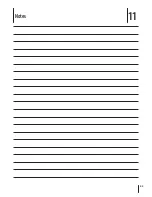
S
ection
6 — M
aintenance
& a
djuStMentS
31
3.
Adjust the eyebolt at the left front of the deck so that the
blade-to-ground height at the right outside blade tip
matches that of the left outside blade tip. This is done by
loosening the jam nuts on the eyebolt and tightening the
upper nut to raise the deck and loosening the nut to lower
the deck. The right outer blade tip height is fixed by the
right, front eyebolt so you must adjust the left outer tip to
match it. See Figure 6-2.
Eyebolt
Jam Nuts
Figure 6-2
4.
Once the proper adjustment is made, re-tighten the jam nuts.
Front-to-Back Leveling
1.
Park the mower on a flat paved surface, engage the parking
brake, shut off the engine, remove the key from the ignition
switch, disconnect the spark plug wires, using the deck lift
pedal position the mowing deck into the 4” height of cut
position (the 4” height of cut position is recommended in
order for one to see and obtain a measurement. Any height
of cut position is acceptable as long as a proper measurement
can be taken) and rotate both outside blades so that they are
parallel with the tractor.
2.
Measure the blade-to-ground height at the right rear blade
tip. Again be sure to measure at the blade tip at the rear of
the right blade when aligned along the mower centerline.
The blade-to-ground height at the rear of the blade tip
should be 1⁄8” to 1⁄4” higher than the front tip. This is referred
to as blade pitch. The same height difference should be
true for the left blade, measured front and back. The pitch
should not exceed 1⁄16
” if cut height is below 1-
1⁄2”.
3.
Loosen the jam nuts at the rear left and right of the deck
eyebolts. Refer to Figure 6-2.
4.
Start at the rear right to raise the rear of the deck, tighten
the upper jam nut to raise the deck or loosen the upper
jam nut to lower the rear of the deck.
5.
Adjust the jam nut at the rear left to take the “slack” out of
the threaded rod.
6.
Tighten both lower jam nuts to secure the deck adjustment.
7.
The final adjustment would be to take the “slack” out of the
left rear linkage if the rear of the deck was raised by adjusting
the jam nuts on the eyebolt. Loosen the jam nuts and tighten
the upper nut to remove “slack”.
In many cases it will be necessary to adjust deck height using both
eyebolt adjustments and pitch adjustment to achieve the correct
blade-to-ground heights. If you remember that the front right
blade tip adjustment is fixed and you level to that height, adjusting
the decks will be simplified.
Deck Wheels
WARNING!
Keep hands and feet away from the
discharge opening of the cutting deck.
NOTE:
The deck wheels are an anti-scalp feature of the deck and
are not designed to support the weight of the cutting deck.
The mower deck cutting height can be set using the tractor’s
deck lift pedal. The deck heights range from 1” to 5”. The deck
gauge wheel position should be approximately 1⁄4 to 1⁄2” above
the ground when the deck is set in the desired height setting.
Using the lift pedal, set the deck in the desired height setting,
then check the gauge wheel distance from the ground below. If
necessary, adjust as follows:
1.
Visually check the distance between the front gauge
wheels and the ground. If the gauge wheels are near or
touching the ground, they should be raised. If more than
1⁄2” above the ground, they should be lowered.
2.
Remove the flange lock nut and carriage bolt securing
the front deck wheel and spacer to the deck. Remove the
wheel and carriage bolt. Refer to Figure 6-3.
Spacer
Carriage Bolt
Flange Lock Nut
Deck Wheel
Figure 6-3
3.
Determine which index hole will give the deck wheel a 1⁄4”
to 1⁄2” clearance with the ground.
4.
Insert the carriage bolt through the appropriate index hole
in the deck wheel bracket, through the spacer, the deck
wheel and out the other side of the bracket.
5.
Note the index hole of the just adjusted wheel, and adjust the
other deck wheel to the same height as instructed in step 3.
















































